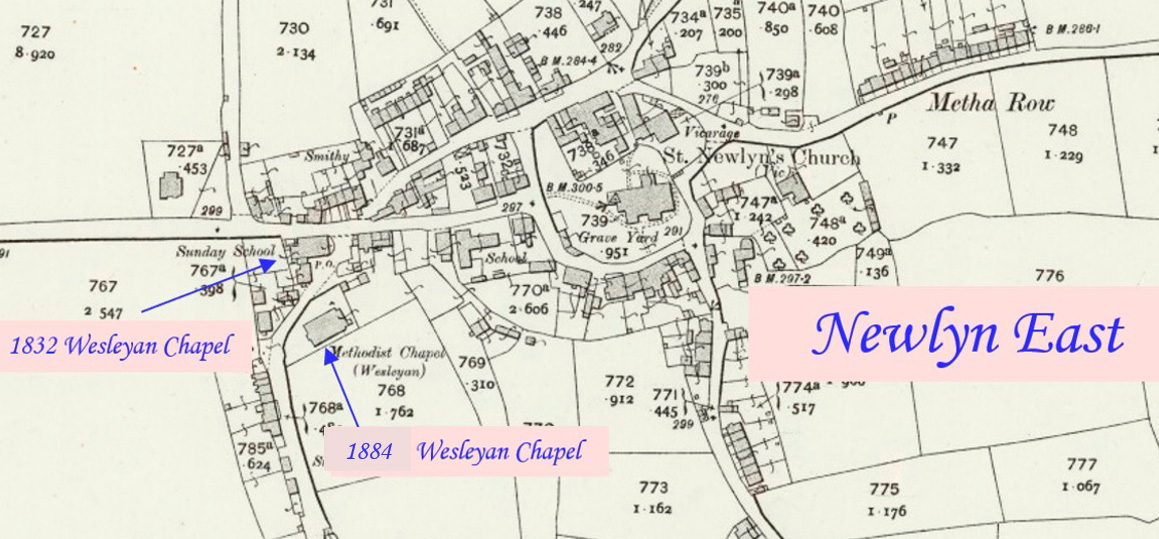
St Newlyn East is a village approximately three miles (5 km) south of Newquay. The name St Newlyn East is locally abbreviated to Newlyn East and according to an anonymous historian writing in The Cornishman in 1880 it was only in recent years that Saint had been added to the parish name. This profile of St Newlyn East Wesleyan Chapel has been compiled by Jo Lewis and Tony Mansell.
1811: Lease, Wesleyan Chapel in Newlyn East. (Kresen Kernow J/1/275) It is thought that this relates to an earlier chapel located on the site where the 1832 chapel was built.
1832: St Newlyn East Wesleyan Chapel built. (Cornwall Council Heritage Gateway)
1870: Newlyn East: “The Band of Hope Festival was held at this place. At 3 o’clock the procession formed at the Wesleyan Chapel, and headed by the Summercourt Band, paraded the various streets, and then went to the Amphitheatre, when the members and several others partook of tea …” (29 April 1870 – Cornubian and Redruth Times)
1871: St Newlyn East: “…the children and committee perambulated the Church-town with other members of the temperance society, headed by the Indian Queen’s Band. Afterwards they proceeded to a field kindly lent by Mr W Rowe and partook of a sumptuous tea. …” (6 May 1871 – Royal Cornwall Gazette)
1878: Lease, site for Methodist Chapel, Newlyn East. (Kresen Kernow J/1/276)
1882: Consents, erection of new chapel, Newlyn East Wesleyan Chapel. Consents from Wesleyan Chapel Committee to erection of new chapel. (Kresen Kernow MRN/599)
1882: “Newlyn East New Wesleyan Chapel. The memorial stones of the new Wesleyan Chapel at Newlyn East were laid on Tuesday week. The ceremony commenced at 3.30 p.m. by the sing of a hymn, followed by prayer by the Rev. E. F Hardwick, of St. Austell, after which the following gentlemen laid the stones: The Mayor of Truro (Mr. W. H. P. Martin), the ex-Mayor of Truro (Mr. A. Jennings, JP) Mr. Henry Browne, St. Austell, and Mr. Carvolth, the oldest member of the Newlyn East Wesleyan Church. A bitterly cold wind with rain and hail prevailing during the ceremony. Immediately afterwards the company adjourned to the old chapel which was soon filled with some four or five hundred persons The Rev. W. Burkett Dalby, minister of the Newlyn East circuit, then presented on behalf of the trustees, a handsome hymn book to each of the gentlemen by whom the stones had been laid. In responding the Mayor of Truro remarked that he and Mr. Jennings had had a great deal to do with the foundation of the Newlyn East Circuit and he congratulated the friends on having not only held their ground, but on having the courage to undertake an enterprise so important as the present. The ex-Mayor also referred to the starting of the circuit eight years ago and said that while proud of what they had accomplished as Methodists, they must disclaim all bigotry and welcome every effort put forth for the progress of religion. Mr Browne, having referred to his father’s connection with Newlyn many years ago, spoke of the embittered state of feeling between the Church of England and the Wesleyans at Newlyn, and trusted a happier time had now arrived. Mr. Carvolth had witnessed the laying of the foundation of the old chapel fifty years ago, and gave reminiscences of the ancient worthies of the Newlyn society… The new chapel will take the place of a very plain and uncomfortable building and will accommodate 600 people. It will be in the Early Gothic style, and very complete and convenient in all its details. The plans are by Mr. J. Ennor, jun., of Newquay, and do him credit. (Royal Cornwall Gazette – Friday 15 December 1882)
1883: Consents, erection of new chapel, Newlyn East Wesleyan Chapel. Consents from Wesleyan Chapel Committee to erection of new chapel. (Kresen Kernow MRN/600)
1884: St Newlyn East Wesleyan Chapel built. (Heritage Gateway)
Seating for 574. (David Easton)
The 1884 chapel was built to replace the previous which became the Wesleyan Hall. This lovely looking building built in English Gothic style prospered for a while with a new Manse being built.
1884: “Wesleyan Methodism at Newlyn East. Opening of the new chapel. Tuesday last was an epoch in the history of Methodism at Newlyn East, when the opening services in connection with their new chapel were commenced. The old place of worship was long ago found insufficient and out of date as to appearance and convenience, indeed, it has been said by a well-known and prominent minister that it might well be worshipped without committing idolatry, as it was unlike anything in heaven above, or in the earth beneath, or in the water under the earth. There were other reasons why another chapel should be provided. The old site was leasehold on three lives, the last died about twelve months ago. There was no other accommodation for their Sunday school, numbering about 300 teachers and scholars. Many unsuccessful attempts have from time to time been made to secure a site both central and easily approached. Eventually a site known as the Bowling-green was purchased by the society at a comparatively low figure, but this was not considered a desirable position, as it was back from a thoroughfare. Through the kindness of Mr. W. Oxnam, the present very commanding freehold site was at length obtained adjoining the main road opposite the old building, in exchange for the Bowling-green, a fine open situation, admirably adapted for the purpose. The chapel is an exceedingly neat and substantial structure of Gothic character well-proportioned in every respect. The external dimensions are 60 feet by 40 exclusive of the vestries and orchestra at the rear. The external walls are of native grey stone with granite dressings. The plan is a parallelogram and is entered from a spacious vestibule extending across the entire width of the building, at each end of which are the staircases leading to the galleries. There are also two doors at the opposite end communicating with classroom, minister’s vestry, orchestra, and galleries. The main front has a central gabled recessed doorway with three-light traceried windows over, flanked by buttresses raised somewhat higher than the roof, and finished with ornamental pinnacles. The side elevations are divided into bays by buttresses with spacious windows having stone mullions and transoms filled with cathedral glass in diamond squares and coloured borders. The pews, stained and varnished deal, are open, and of ample width, the side seats being put on the angle. The principal roof timbers are visible with plaster ceilings well ventilated. The rostrum (of very neat design) and communion are of varnished pitch-pine. The galleries extend only eight feet from the side walls and 17 feet from the end, and do not detract from the architectural effect of the interior; the fronts are of varnished pitch pine and have a nice appearance. The chapel is lit by eight chandeliers suspended from the roof, each having three pretty petroleum lamps. It will accommodate about 600 persons, and when all the details have been completed it will cost about £1,750, of which nearly three-fourths have been raised. The plans were furnished by Mr. John Ennor, of Newquay, under whose superintendence the work has been carried out by Messrs. J. Hawkey (Newlyn East), Jury Bros. (St. Austell), and Best and Bennetto (St. Dennis and St. Enoder), to the satisfaction of the Building Committee. The ceremonies on Tuesday, with their attendant accessories, comprised a prayer meeting at 7, a public service at 11, conducted by the Rev. Edward Watson, of Redruth, chairman of the district, who preached an appropriate and instructive sermon from St. John, i., 1, “In the beginning was the Word, and the Word was with God, and the Word was God.” The Rev. S. J. P. Dunman, of Truro, read the lessons. There was a large and appreciative congregation. A luncheon followed at 1 o’clock, the viands being given by the ladies and friends of the society. The Rev. James Hartle, of Newlyn East, said grace. Many willing hands had been and were busy, and nothing was wanting to give everyone present the greatest satisfaction. At three o’clock another public service was commenced to an almost inconveniently crowded congregation by the Rev. Rd. Allen, superintendent of the Truro circuit, when the Rev. Edward Watson again preached a well thought out and eloquent sermon, taking his text from Ezekiel.iv., 18, “Behold all souls are Mine.” In concluding this touching discourse, the rev. gentleman eulogized the beautiful place of worship, and finished by saying “In Yorkshire phrase. I have taken to this chapel more than any other I have seen.” Tea was provided in the old chapel at 5 o’clock, to which a very large number sat down. At seven a public meeting was held, presided over by Mr. John Doidge, of Truro, who was accompanied on the platform by the Revs. R. Allen and J. P. Dunman, of Truro, and Mr. John Grose, secretary to the Building Committee. The new building was crowded in every part. The chairman, in his very appropriate opening speech, complimented the Methodists of the Newlyn circuit upon having raised such a beautiful chapel in which to worship God. It well merited the prominent position it held as the central chapel of the circuit. Worshipping God was the grandest and noblest employment in which man could engage, and it was the duty of all to do their utmost to procure a house worthy of such service. Mr. Grose, in presenting his report, complimented the society on having got over their difficulties in procuring the present site, which has been acknowledged to be the best that could be found, and erecting their new chapel, towards the cost of which they had raised by bazaars, subscriptions, policy of assurance, &c, £1,150. There was also £50 more promised, and the Chapel Committee were prepared to lend £60 for ten years without interest. This made a total of £1,260, and if they could by the opening services realise £100 they hoped soon to have three-quarters of the total cost contributed, when they would be able to claim a grant of £50 from the Methodist Chapel Extension Society. He hoped and believed they would do their best to get this grant for although several of his hearers would never forget the old sanctuary, he felt sure they would all agree will him that their new chapel was a credit to the place and the circuit. The Revs. S. J. P. Dunman, and R. Allen afterwards delivered appropriate addresses. Votes of thanks to the chairman, speakers, and the Bolingey choir kindly assisted by the well-known Mr. Edward Veale, of Perranporth, who were in attendance throughout the day, and rendered excellent service, terminated the proceedings.” (Royal Cornwall Gazette – Friday 10 October 1884)
Trust minutes 1886-1890, Newlyn East Wesleyan Chapel. (Kresen Kernow MRN/54)
The 1832 chapel converted to Sunday school. (Cornwall Council Heritage Gateway)
1884: Due to increasing numbers a larger church was built over the road. This building then became the Wesley Hall, used for children’s activities and village events.
1912: Newyln East Wesleyan: “… Tea was served in the pit, and the remainder of the evening was spent in games. Selections were rendered by Newlyn East Brass Band, who have made rapid progress.” (27 June 1912 – West Briton and Cornwall Advertiser)
Trust minutes 1891-1922, Newlyn East Wesleyan Chapel. (Kresen Kernow MRN/55)
1932: The Wesleyan, Primitive Methodist and the United Methodist Church amalgamated to become the Methodist Church of Great Britain.
1932: Became Newlyn East Methodist Church.
1980: The 1832 chapel renovated.
1982: The 1884 Newlyn East Methodist Church closed. (SWChurches)
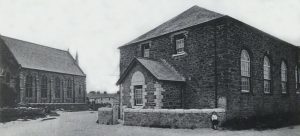 The two chapels (Photo: Barry West)
The two chapels (Photo: Barry West)
1980s: The 1832 Chapel/Sunday school in use as a chapel again. (Heritage Gateway)
The 1884 chapel was sold for development.
1990: The 1884 Newlyn East Methodist Church closed and the congregation using the Sunday School (1832 chapel). (David Easton)
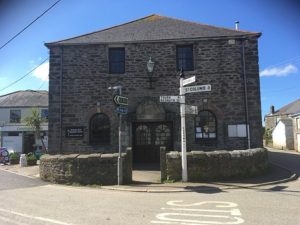 The 1832 Newlyn East Wesleyan Chapel (Photo: Jo Lewis)
The 1832 Newlyn East Wesleyan Chapel (Photo: Jo Lewis)
The simple mass of the Wesleyan Methodist Chapel. Built from similar materials to the church but far more austere; its façade of square headed windows is articulated only by a simple porch and its aisles by semi-circular windows with brick arches. (Cornwall Industrial Settlements Initiative)
Original Wesleyan Methodist chapel built 1832 and recorded on the 1st edition 1:2500 1880 OS Map. Converted to Wesleyan Sunday school sometime after 1907 following the construction of a new chapel to the south. Now used for worship as a chapel. Altered at the front. Stone rubble with granite quoins. Round brick arches to ground floor, sashes to 1st floor, hipped roof. Presumed to have end gallery. Listed in Stell (b1). (Cornwall Council Heritage Gateway)
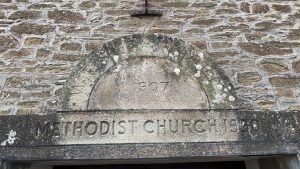
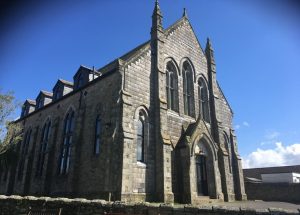 The 1884 Newlyn East Wesleyan Chapel (Photo: Jo Lewis)
The 1884 Newlyn East Wesleyan Chapel (Photo: Jo Lewis)
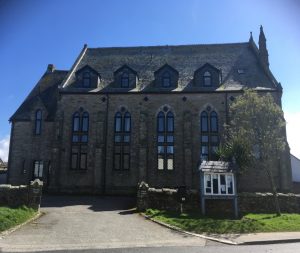 The 1884 Newlyn East Wesleyan Chapel (Photo: Jo Lewis)
The 1884 Newlyn East Wesleyan Chapel (Photo: Jo Lewis)
Now been converted into flats.
The building could be mistaken for the parish church with its early English gothic windows and projecting decorative buttresses. Only the somewhat incongruous dormer windows reveal the building’s modern domestic nature. (Cornwall Industrial Settlements Initiative)
Fairly large Methodist chapel, disused and likely to be converted to flats. Built 1884 (b1). Coursed rubble with granite dressings, part later slate hanging at the front; dry Delabole slate roof with decorative fish scale courses and crested and pierced clay ridge tiles; coped gable ends. Gothic style with buttressed bays and traceried window heads. 3-bay front with stepped paired lights above gabled porch with flanking lights; diamond-pane leaded lights. Rubble forecourt walls with rock-faced copings; dressed granite gate-piers with cruciform caps; pair of wrought-iron gates. (Cornwall Council Heritage Gateway)

My Great Uncle was a Wesleyan Minister at St Newlyn East. His name was Edward Rees Polsom. I have his obituary from the Methodist Times. He died as a result of an accident while there but have never found out what happened. Any information about him would be greatly appreciated.